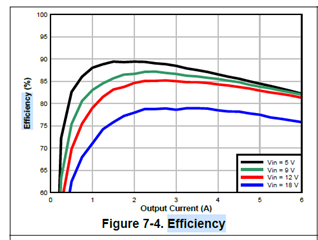Other Parts Discussed in Thread: TPS543820E
Hello, I'm looking at the datasheet for the TPSM843620E and would like to know the output voltage of the efficiency curve in 7.2.1.3 page 27:

This thread has been locked.
If you have a related question, please click the "Ask a related question" button in the top right corner. The newly created question will be automatically linked to this question.
Hello, I'm looking at the datasheet for the TPSM843620E and would like to know the output voltage of the efficiency curve in 7.2.1.3 page 27:

Hello and thank you very much for resonding to my post. Question, what exactly is considered "high efficiency"? Now I have to admit I am not a guru with these parts but just looking at the curves I would not say this device has high efficiency. What am I missing here to that can better understand things? It doesn't even break 90%.
If you have a specific use case, the webench tool can help you narrow your search from controller, converters and modules, here is a link Power Designer (ti.com) Controller use external mosfets, Converters intergate the mosfets and the modules integrate the integrate inductor.
The webench tool can use small footprint, high efficiency, low cost or balance as a weight when designing a solution.
The Efficiency calculation is Vout*Iout/Vin*Iin, the 1V is a lower output therefore the efficiency will be lower than 3.3V output for example.
The TPSM843620E uses a variant of the TPS543820E IC as the converter, the IC datasheet has 3 efficiency curves at different output and at least avoids the subjective term "high efficiency" on the front page feature bullets. The IC has the flexibility of using different inductors which can influence the efficiency from dc and ac losses.